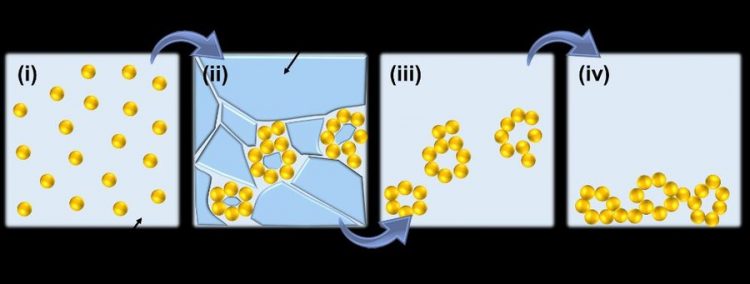Noble Metal Aerogels Enabled by Freezing: Multi-Scale Structured Materials for Electrocatalysis and Photoelectrocatalysis

Schematic presentation of the freeze-thaw method. © Wiley-VCH
As a new class of porous materials, noble metal aerogels (NMAs) have drawn tremendous attention because of their combined features including self-supported architectures, high surface areas, and numerous optically and catalytically active sites, enabling their impressive performance in diverse fields.
However, current fabrication methods suffer from long fabrication periods, unavoidable impurities, and uncontrolled multiscale structures, discouraging their fundamental and application-orientated studies.
Dr. Ran Du from China has been an Alexander von Humboldt research fellow at TU Dresden since 2017. In collaboration with the Dresden chemists Dr. Jan-Ole Joswig and Professor Alexander Eychmüller, they recently crafted a novel freeze-thaw method capable of acquiring various multi-scale structured noble metal aerogels as superior photoelectrocatalysts for electro-oxidation of ethanol, promoting the application for fuel cells.
Their work has now been published as cover story in the prestigious journal Angewandte Chemie International Edition.
Ran Du and his team have found unusual self-healing properties of noble metal gels in their previous works. Inspired by this fact, a freeze-thaw method was developed as an additive-free approach to directly destabilise various dilute metal nanoparticle solutions (concentration of 0.2-0.5 mM).
Upon freezing, large aggregates were generated due to the intensified salting-out effects incurred by the dramatically raised local solute concentration; meanwhile, they were shaped at micrometer scale by in situ formed ice crystals. After thawing, aggregates settled down and assembled to monolithic hydrogels as a result of their self-healing properties. Purified and dried, clean hydrogels and the corresponding aerogels were obtained.
Due to the hierarchically porous structures, the cleanliness, and the combined catalytic/optical properties, the resulting gold-palladium (Au-Pd) aerogels were found to display impressive light-driven photoelectrocatalytic performance, delivering a current density of up to 6.5 times higher than that of commercial palladium-on-carbon (Pd/C) for the ethanol oxidation reaction.
“The current work provides a new idea to create clean and hierarchically structured gel materials directly from dilute precursor solutions, and it should adapt to various material systems for enhanced application performance for catalysis and beyond”, assumes chemist Ran Du.
Media Enquiries:
Nicole Gierig
Public Relations Advisor
School of Science
TU Dresden
Email: Nicole.gierig@tu-dresden.de
Du, R., Joswig, J.-O., Hübner, R., Zhou, L., Wei, W., Hu, Y., Eychmüller, A. (2020). Freeze-Thaw-Promoted Fabrication of Clean and Hierarchically-Structured Noble Metal Gels for Electrocatalysis and Photoelectrocatalysis. Angew. Chem. Int. Ed., DOI: 10.1002/anie.201916484.
Media Contact
All latest news from the category: Life Sciences and Chemistry
Articles and reports from the Life Sciences and chemistry area deal with applied and basic research into modern biology, chemistry and human medicine.
Valuable information can be found on a range of life sciences fields including bacteriology, biochemistry, bionics, bioinformatics, biophysics, biotechnology, genetics, geobotany, human biology, marine biology, microbiology, molecular biology, cellular biology, zoology, bioinorganic chemistry, microchemistry and environmental chemistry.
Newest articles

Superradiant atoms could push the boundaries of how precisely time can be measured
Superradiant atoms can help us measure time more precisely than ever. In a new study, researchers from the University of Copenhagen present a new method for measuring the time interval,…

Ion thermoelectric conversion devices for near room temperature
The electrode sheet of the thermoelectric device consists of ionic hydrogel, which is sandwiched between the electrodes to form, and the Prussian blue on the electrode undergoes a redox reaction…

Zap Energy achieves 37-million-degree temperatures in a compact device
New publication reports record electron temperatures for a small-scale, sheared-flow-stabilized Z-pinch fusion device. In the nine decades since humans first produced fusion reactions, only a few fusion technologies have demonstrated…





















